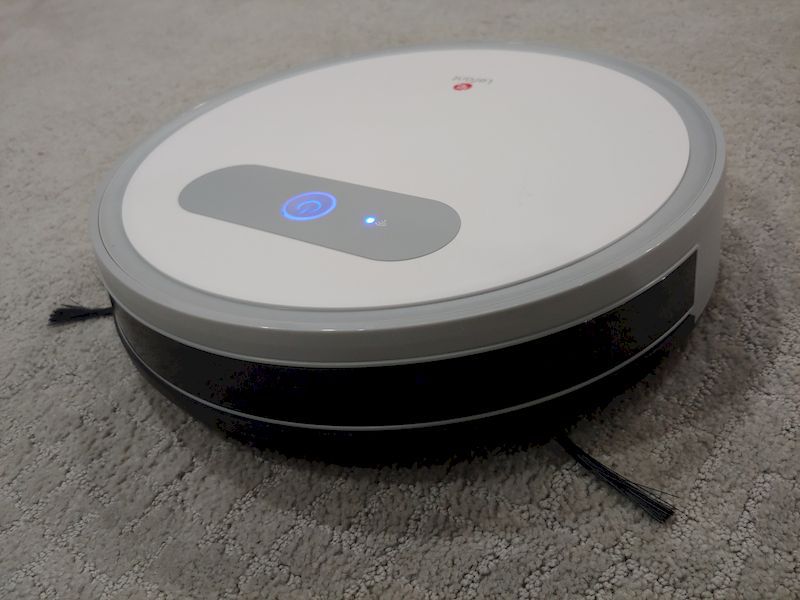
REVIEW – These days there are quite a few Chinese companies selling robot vacuums to compete with iRobot. The marketplace is similar to the plethora of Chinese manufacturers of action cameras that compete with GoPro. There are tradeoffs to quality, price, features, and performance. The Lefant M500 is a robot vacuum with low to middle range price and performance. Read on to see what I think!
What is it?
The Lefant M500 robot vacuum cleaner and mop is a self-propelled and self-guided vacuum and mop. It has several infrared sensors which it uses to sense the surroundings. It also has WI-FI Connectivity to allow the vacuum to be scheduled and remotely started and stopped from anywhere in the world. The vacuum is rated for 1200Pa, enough suction to be able to lift water in a straw about 5 inches. The motor, when operating at full power, is still very quiet. When the vacuum senses that the internal battery is at low charge it automatically returns itself to the charging station to recharge.
What’s in the box?
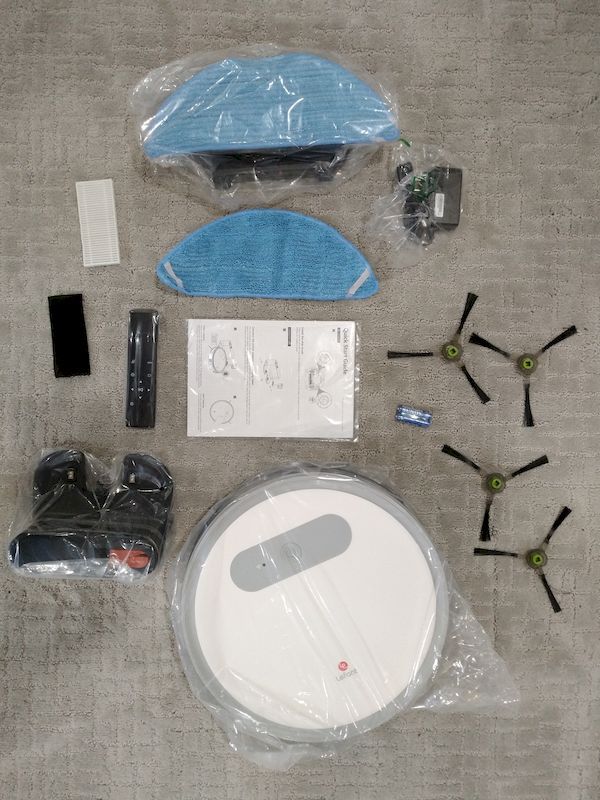
The Lefant M500 comes with the following:
- Robot Vacuum
- charging stand and US-prong power adapter
- remote control and alkaline batteries
- spare sponge filter
- spare final filter
- mop assembly
- spare mop pad
- instruction manual and warranty card
- main and spare set of sweeper brushes
Hardware specs
The Lefant M500 has the following specifications:
- Suction: 1200Pa
- Electrical Power: 20W
- Battery Capacity: 2600mAh
- Free Move Technology
- Wi-Fi Connected
- Remote Control
- Adjustable Suction Power
- Auto Charging
- Dust Box Capacity: 0.6L
- Water Tank Capacity: 0.285L
- Cleaning Time: Around 2 hours
Design and features
Unboxing
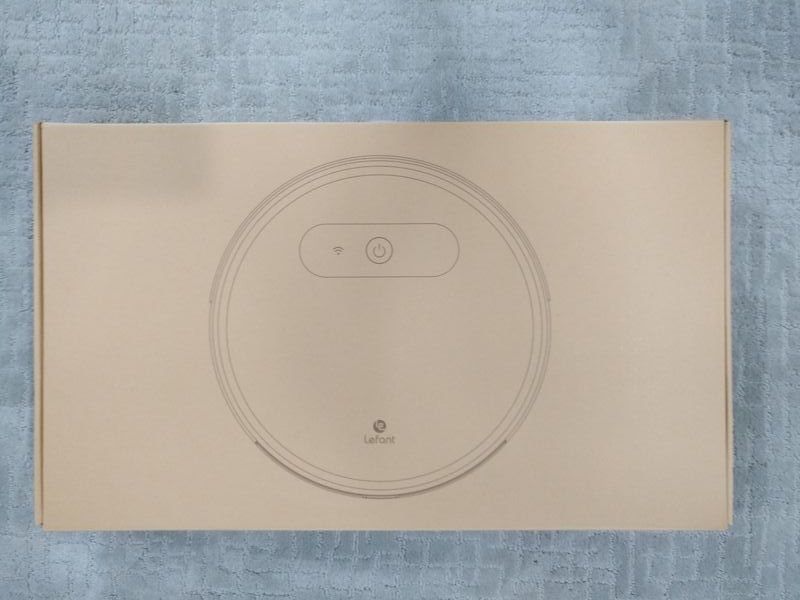
The Lefant M500 comes in an unassuming cardboard box. The lid of the box has a depiction of the vacuum inside. Within the box, the components are neatly and securely packed within molded cardboard.
Design
The design of the Lefant M500 follows the standard set by iRobot. It is a squat cylinder designed to turn on a dime and to fit under the furniture. On Amazon, the manufacturer points out that the unit is designed with unibody construction. I’m not sure if other manufacturer’s designs are significantly different. The plastic has a matte texture, which will be more resistant to showing scratches than a glossy finish. The IR band across the front is glossy, and that already has scuffs from the trail runs I have conducted.
The IR window conceals 12 IR transceivers in an overlapping pattern. To see what this looks like I used a camera that has IR active focusing and can see the IR illumination. The violet-hued lights in the picture below are invisible to the naked eye. The robot can sense this light and looks for the reflection of this light against objects in its path to judge distance.
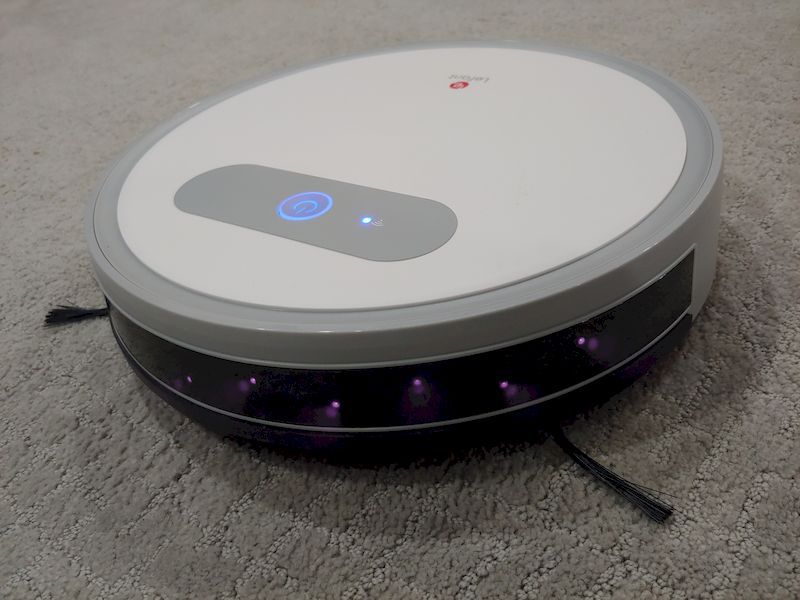
To see how this works in real life, check out this video of different robot vacuums making a dark room very clean:
The robot also has 3 sensors on the bottom – one in front of the front wheel and one on either side fo the drive wheel. These protect the vacuum from falling downstairs. The bottom also has a sweeping brush on the left and right side. The bristles are angled down according to the direction that the brushes rotate so make sure that the correct facing brush goes on the appropriate drive stem on each side of the unit. The bottom also has a door to access the battery. The better brush is in an easy to access door on the bottom. The charging base comes with a tool to clean this and to cut loose any hairs or fibers that get caught around the rotating shaft. The drive wheels on the base are deep treads and can extend about an inch if the vacuum gets hung up on a table base or runs over some wires or other items.
The rear of the vacuum has a master power switch on one side of the rear and the exhaust to the vacuum motor on the other. The center of the rear is where the dust bin and mop water reservoir attach. The dust bin has a spring clip that holds it in place. Once it is removed the bin opens up like a clamshell and the debris collected can be removed.
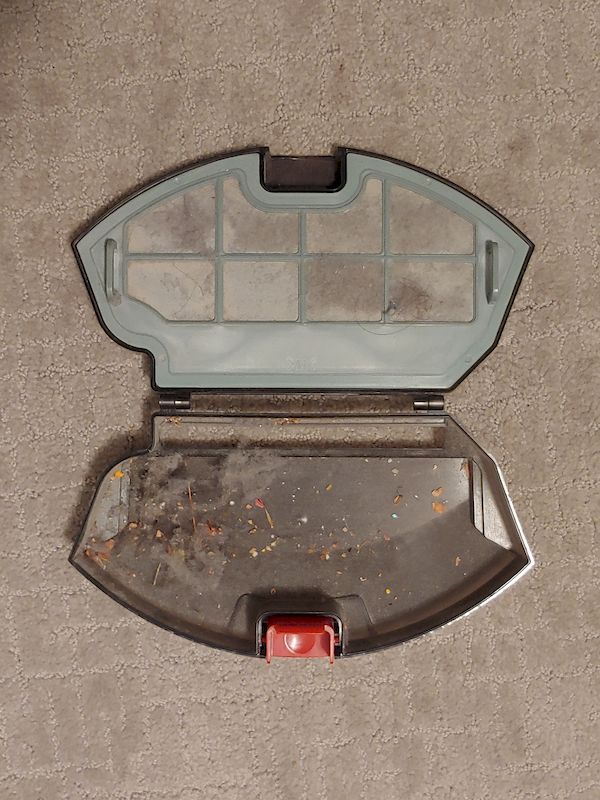
The bin has three levels of filtration between the dust bin and the vacuum motor: a prefilter made of a fine plastic screen, a secondary filter made of sponge material, and a final filter made of pleated filter material. Here is the bin with the prefilter removed and showing the dirty side of the sponge.
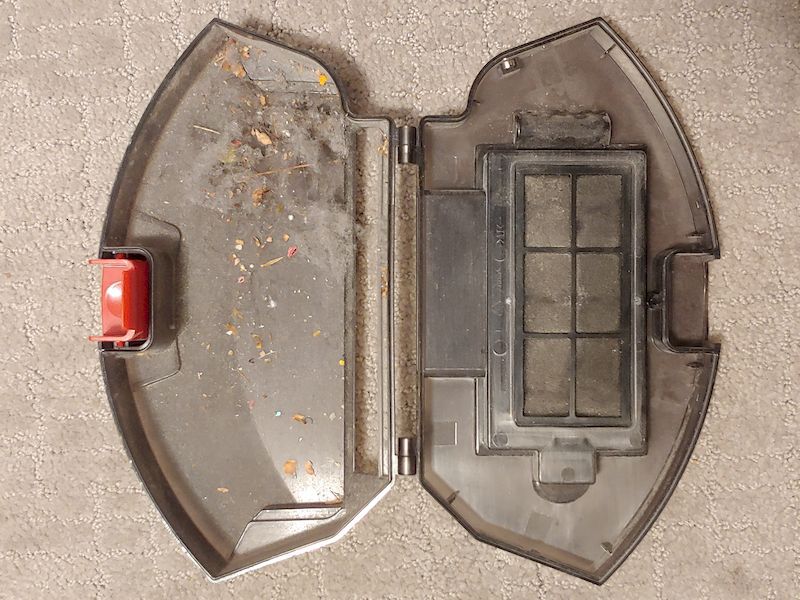
Here is the topside with the final filter exposed.
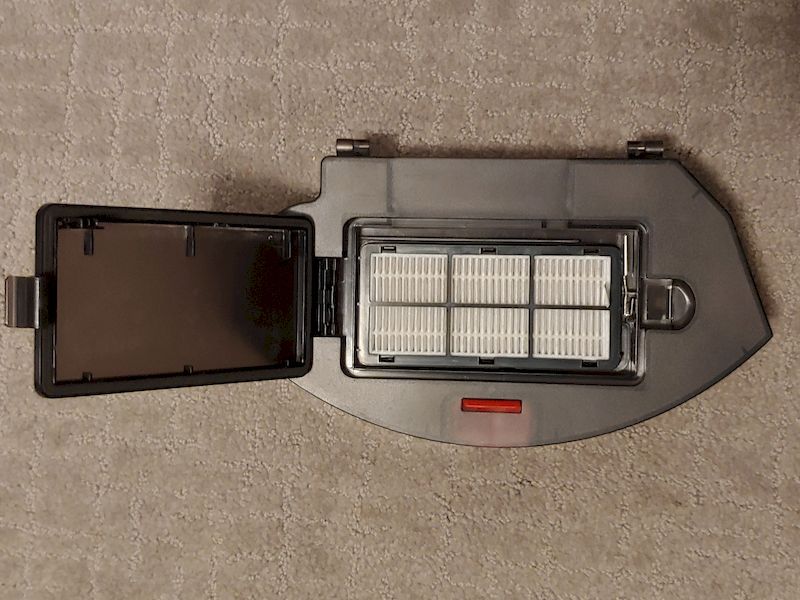
Note that the plastic frame holding the final filter in place is asymmetric so that the filters are not installed upside down.
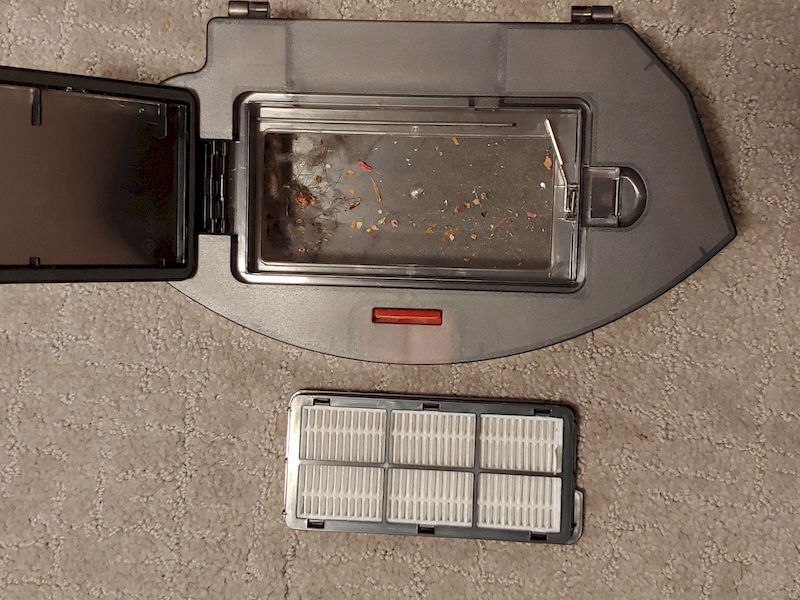
The filters can be reused several times before washing but each should eventually be washed to maintain vacuum performance. The screen and sponge can be washed in water to restore permeability but the final filter should only be tamped clean. The water reservoir can be switched with the dust bin for mopping. A small magnet in the water bin and the dust bin let the robot know what mode to operate in. The water reservoir has a 250 mL capacity. The mop material is attached by velcro to the base of the reservoir. Here is the base with the mop material removed. You can see the five holes that wet the mop from above.
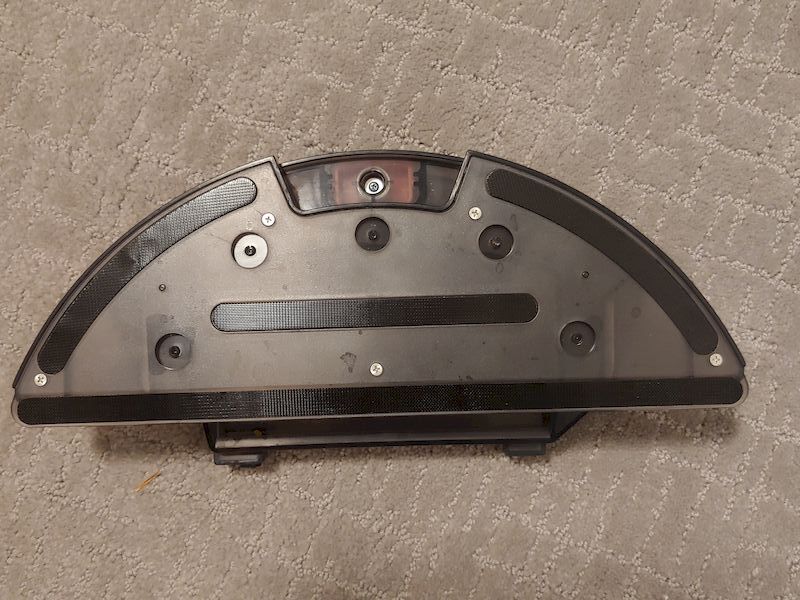
The rate at which the mop is wetted is controlled by an air pump built into the vacuum motor. Here’s a close up of the air pump nozzle.
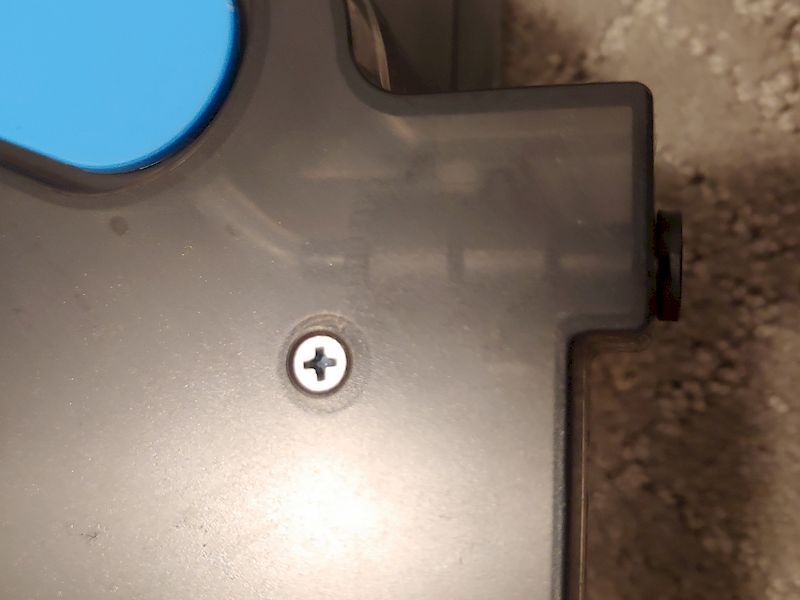
The mop should only use water since the water is not sucked up by the robot after being dispensed. The benefit of using the robot mop is that the robot’s self-guidance and small stature can push the mop around automatically and into hard to reach places.
The robot is started in one of three ways: the large power button on top of the robot, the remote control, and the app. The power button starts the robot in auto mode and at normal power. The robot will move around the room in a programmed manner. In open spaces, it will approach a wall, move a short distance to account for the width of the brush and turn back to where it came. If it is in tight spaces it will circle the nearest objects until it can travel in a straight line. The sweeper will slow down before reaching the obstacles to avoid hitting and scratching furniture or delicate items. If it is adjacent to a wall it will perform a series of small semicircular arcs to get as close to the wall as possible. Unless the vacuum is operating in a completely rectangular room with nothing on the walls it may not cover every area. Pushing the button on the robot will stop the robot where it is – it will not return to the charger on its own.
The remote and the app allow the same interaction with the robot. Both allows the selection of returning to the charger, operating in any of the modes, controlling power, and remote controlling the direction of the robot. The app allows the start operation of the robot to be remotely timed but does not allow the operation to be stopped. The app also allows more precise control of the power and mop water dispensing rate. The remote and app both allow the robot to be used in spot mode, which will clean a circular area about four feet across for two minutes. The robot also has an edge cleaning mode which will focus on cleaning the perimeter of a room. In this mode, the robot will always turn left around the room and eventually return to the charger.
The iOS and Android app both suffer from mediocre translation, but the gist of what each function is is obvious and is much better than I could probably do in making a Chinese app. This is the main screen on the iOS version
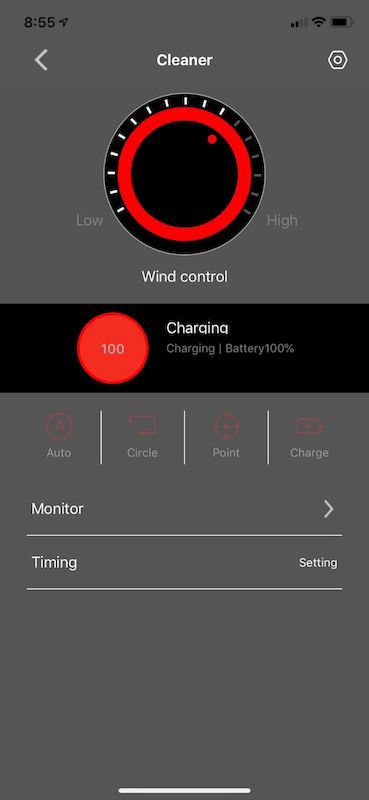
Here is the Android version
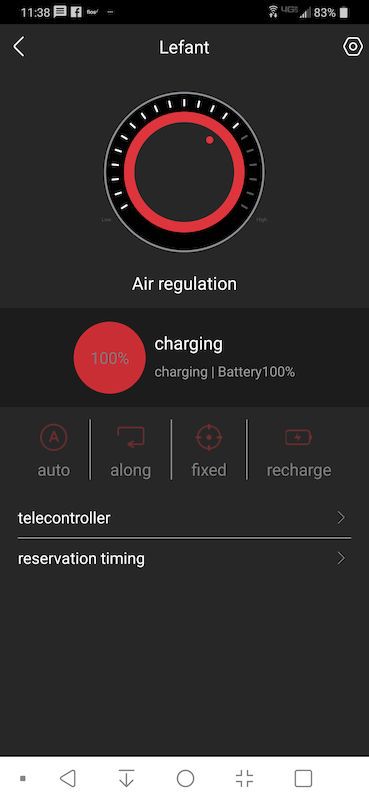
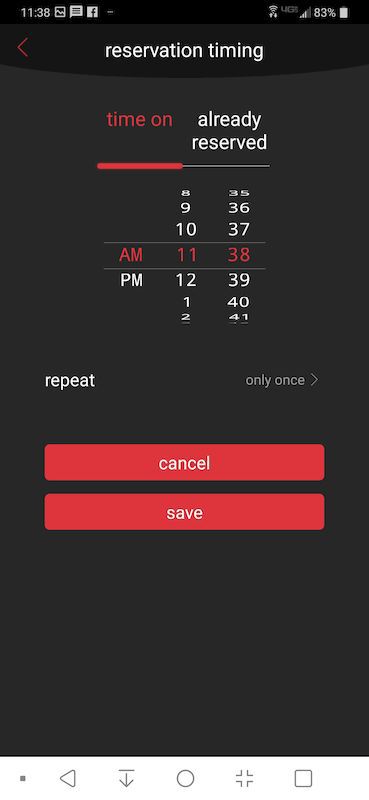
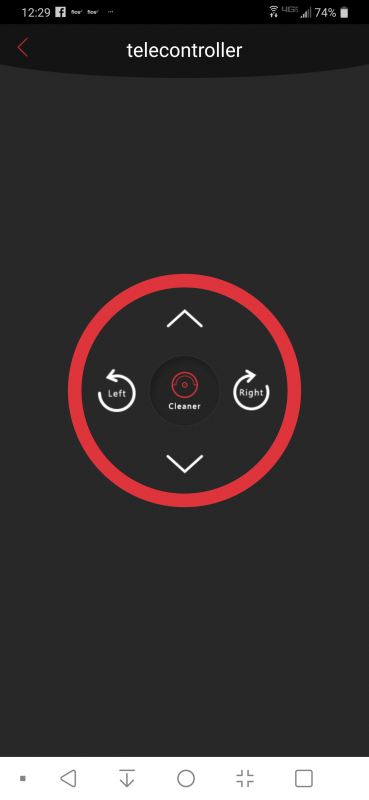
Nigel Tufnel would appreciate that the iOS suction goes to 16 but the Android version goes to 21. The UI on the Android app is compatible with Tasker and AutoInput. I made routines for starting and charging my vacuum (using the Exit App task). These can be started using any of the profile triggers in tasker or combined with AutoVoice to enable Alexa/Google Assistant integration.
The app also permits OTA upgrades. While evaluating the robot the manufacturer released an update. There were no release notes and I can’t tell what changed, but the upgrade occurred OTA without a hitch.
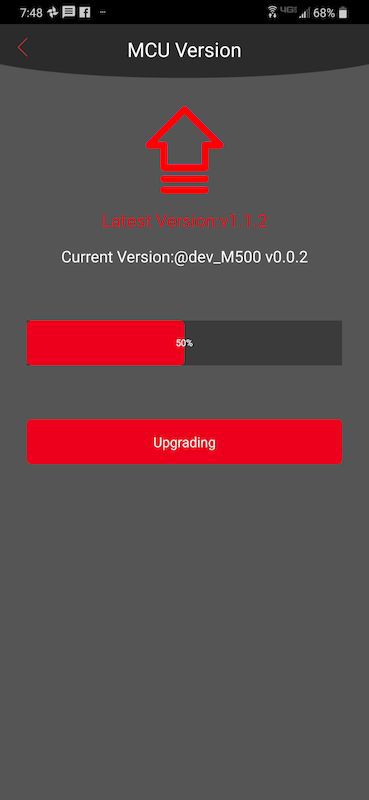
Setup
The manual recommends a three-foot clearance to the left and right of the charger and a six-foot clearance in front of the charger. I found that the robot can find it’s way back to it in tighter clearances but it may run into issues. The rooms that the vacuum is working in should also have all of the power lines put away. Tassels or fringe on the carpet should be tucked under I caught my vacuum just before it fell down the front stairs of my house, so the anti-drop IR may not be as functional as indicated.
Binding the robot to my phone was easy. A mailinator SMS phone number works fine if you don’t want to provide your real cell number. You do need to provide the WIFI password so that it can attach itself to your wifi network. I used an Android pie and an iOS 12.4 mobile and had no problems on either. OPddly, the program changes your mobile’s Bluetooth name to “wifi”. The system can only bind to one WiFi but there is a share option in the swipe menu that will allow the robot to be set up on another phone.
Performance
Since this is a 20W unit and the published suction on the vacuum is 1200Pa = 4.82 inH2O, the maximum theoretical flow out the exhaust is 35 CFM. The performance of this unit is more along the lines of a handheld vacuum and it is about half the suction and a fifth of the flow of most upright vacuums. In comparison, this unit has a brush and cleaning width about half of most uprights, so a smaller flow is acceptable, but a higher ultimate vacuum would result in better cleaning. The more expensive competitors have higher suction ratings.
I found that since there is always something in a corner or furniture that may not be perpendicular to the wall, that the robot often ended up making a criss-cross pattern and didn’t always cover each area of the rug, even after a considerable time. This robot doesn’t have laser distance scanning or use advanced placement algorithms so there is no way for it to know if it has missed a section of floor. I did have it clean under the dining room table and even though the chairs were still in place the vacuum did a good job maneuvering around and between them.
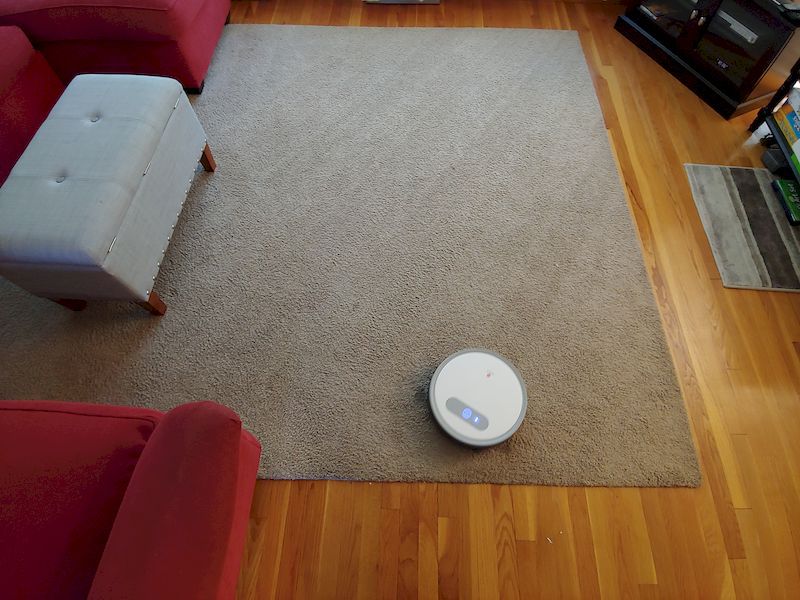
When transitioning from a wood floor to carpet the robot often left a pile of debris. Whatever is being pushed along by the brushes but not sucked up is probably deposited in these transitions.
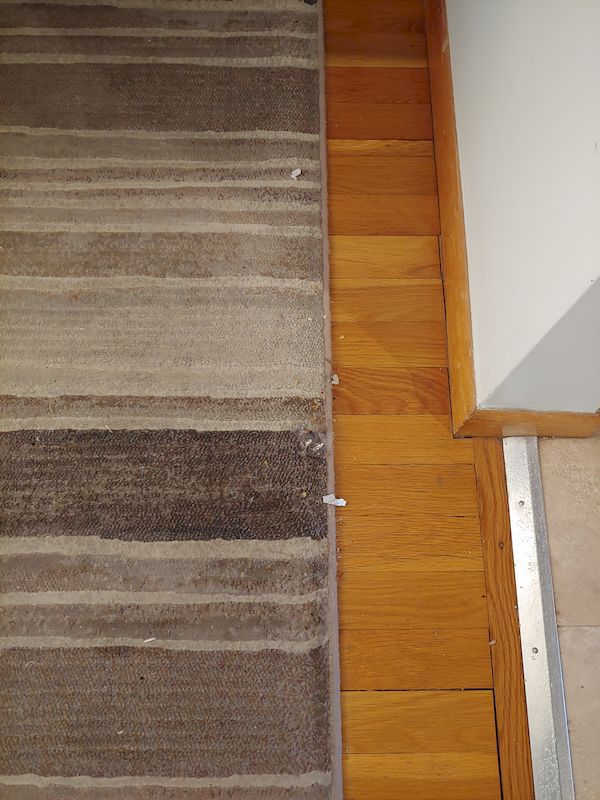
Overall I found that the robot vacuum sucked up a good deal of lint and dirt, but occasionally the robot missed a scrap of paper or a dead leaf tracked in from outdoors. I suppose that its killer feature is being able to go under beds and furniture to clean these areas that a normal vacuum just can’t reach.
The mopping feature is also very useful. I found that the fact that it has a controlled wetting of the mop fibers and a very deliberate speed made mopping more effective than when it is performed by a human.
Of course, the real reason to get a robot vacuum is to get pics of your pets on top of them!
What I like
- Good results cleaning and mopping
- WiFi connectivity allows good remote control
What I’d change
- Improve bottom brush assembly (to avoid debris at level changes)
- Natively support the ability to turn off or charge remotely.
Final thoughts
If you are looking for a quiet, connected robot vacuum that may not get every last bit of dirt but will do a reasonable job keeping your floors and carpets clean, then the Lefant M500 may be for you. But, with a large number of robot vacuums available there is likely a model with the exact features, performance, and price that you are looking for. Also, there may be better values available for the same cost. For instance, the Roborock S25 also costs $249 on Amazon, and has many of the same features as the Lefant, but also includes route planning, voice control, and greater suction.
Price: $249
Where to buy: Amazon
Source: The sample of this product was provided by Lefant.



Gadgeteer Comment Policy - Please read before commenting
How does the M500 compare to the M520 or T700?
Or are there other better models I could get in this price range.
Not sure at how impressed I am with the M500. Also Amazon says 2000pa suction, but U say 1200pa – which is correct??
Did you ever get a vacuum? which model? The suction rating by the manufacturer is 1200 pa.
Where do you buy replacement batteries?
I really like the Lefant robot, however, after the first time, the mopping feature does not work… The water tank keeps falling out, for no apparent reason… Wondering if I can tape it closed… ;o(
I would suggest making sure the spring clip in the back is working properly and that the mop isn’t getting caught in the gap between the robot body and the tank.